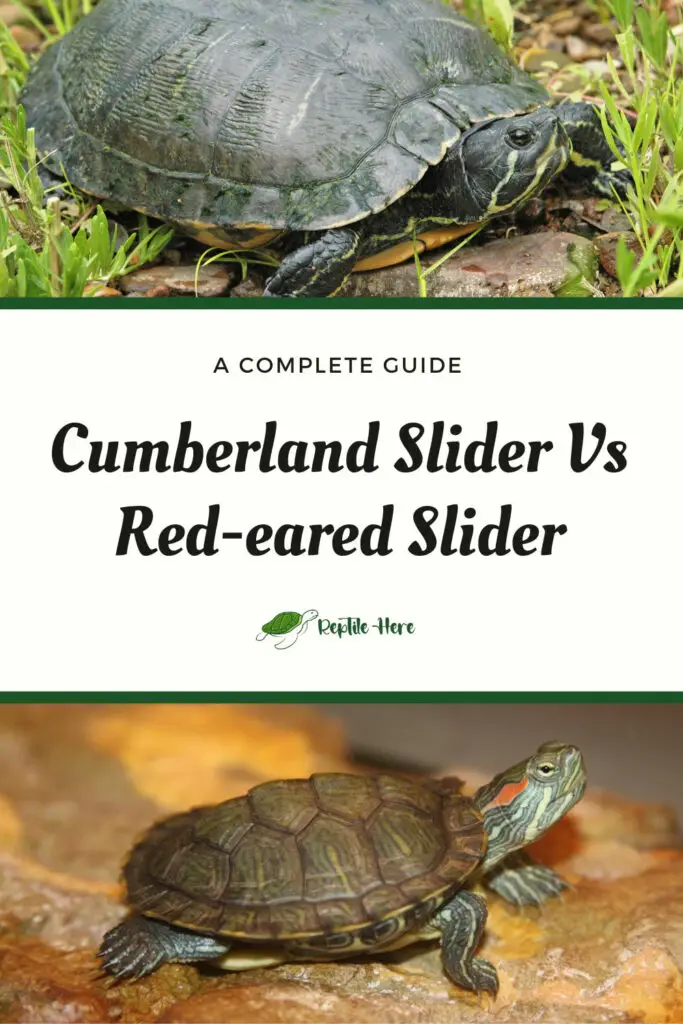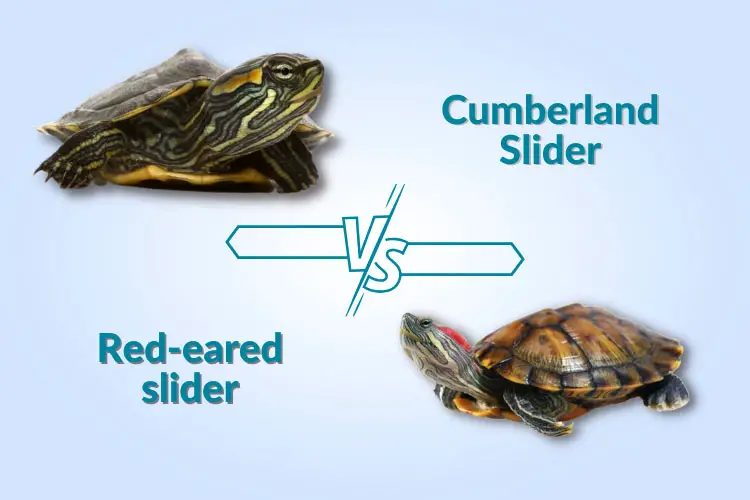Cumberland Slider Vs Red-eared Slider: What Are The Differences?
Cumberland and red-eared sliders are close relatives. They belong to the same species of pond slider turtles. If you’re trying to choose between a Cumberland and a red-eared slider, this guide will help make a more informed decision.
Cumberland slider vs red-eared slider key difference lies in their physical appearance. The Cumberland slider has a narrow yellow color bar behind its eye; the red-eared slider features a distinctive, broad red strip behind its eyes.
The following article will provide you with full details about Cumberland vs red-eared slider turtles. We have discussed how the two compare in terms of difficulty of care, housing, diet, lifespan, behavior and temperament, and more.
Cumberland slider vs red-eared slider comparison table:
Contents
| Cumberland slider (Trachemys scripta troostii) | Red-eared slider (Trachemys scripta elegans) | |
| Size | 5 to 11.4 inches | 5 to 12 inches |
| Diet | Omnivore | Omnivore |
| Temperament | Friendly | Friendly |
| Care Level | Beginner | Beginner |
| Cost | $15 to $40 | $10 to $25 |
| Minimum tank size | 75 gallons | 75 gallons |
| Conservation status | Least Concern | Least Concern |
| Lifespan | 30 to 40 years | 20 to 30 years |
Cumberland slider vs red-eared slider (side-by-side comparison):
As you can see from the previous table, the Cumberland and red-eared slider share many similar characteristics. This is easy to understand given that the two turtles are pretty close relatives belonging to the pond sliders turtle species.

Below is our side-by-side comparison of these two turtle species as pets:
Physical characteristics
The Cumberland species has an olive-green to brown carapace with yellow markings. Its skin is brown, light greenish, or olive and features yellow stripes.
Its plastron is also yellow and features dark spots around its edges. A distinct color bar also appears behind the Cumberland slider’s eye. It starts as yellow and fades towards dark orange or red as you move closer to the back side of its neck. The color bar appears thin or thick.
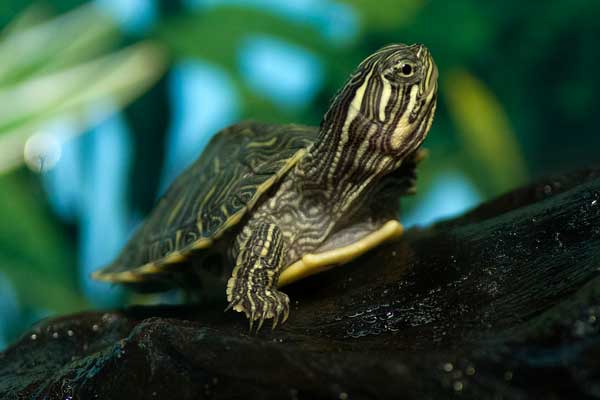
The red-reared slider’s skin and carapace both bear green or brown color. In addition, the skin features stripes, and a red patch that’s jelly bean shaped sits behind the turtle’s eye (hence their name, red-eared turtle).
The plastron of this turtle is usually bland yellow and has black spots with varying shapes. As this turtle matures, its color grows darker and it appears duller—making the shell and skin patterns more ambiguous.
Habitat
The Cumberland slider and red-eared slider require the same habitat setup, with the same list of items and supplies.
You’ll first need to choose the ideal size of tank for your slider. The hatchlings will live comfortably in a 20-gallon tank while the adult sliders will do well in a 75-gallon or 100 to 125-gallon tank (for females).
The red-eared slider or Cumberland slider tank setup should include a spacious swimming area. It should also have a dry land or basking area for your pet to completely get off the water and dry off as well as soak in UV rays.
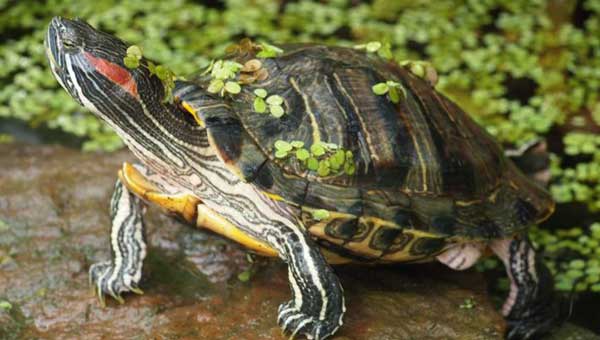
The tank should be equipped with a robust filter system, water heater, and a basking light.
The water temperature should be maintained at 75 to 80 degrees F while the basking area temperature should fall between 85 and 95 degrees F.
The basking light should stay on for 10 to 12 hours every day, regardless of the season, just like the natural sunlight.
If you want, you can also add substrate and other turtle tank décor, including live plants hide spots, rocks, gravel, etc., to help improve your tank’s overall aesthetics.
Diet
A nutritious diet is essential for your pet turtle’s good health. That said, the Cumberland slider food is the same diet as that of a red-eared slider. A Cumberland slider is omnivorous in adult age but primarily carnivorous in juvenile age.
The adult will feed on both plant and animal matter including dark leafy greens, aquatic vegetation, small fish, worms, crayfish, insects, and mollusks. the same goes for the adult and baby red-eared sliders.
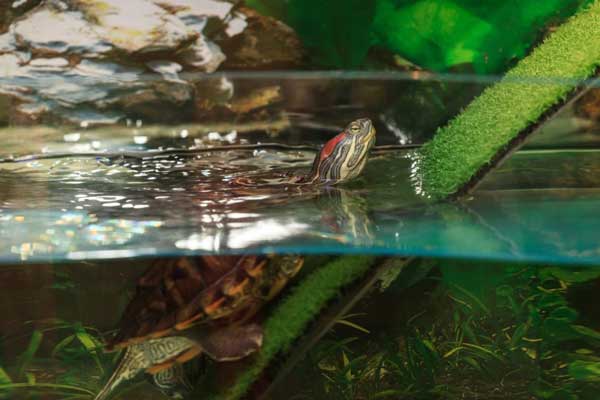
For adult Cumberland and adult sliders, you can feed them every other day while their hatchings will need to eat more often (i.e., every day). As for the food quantity, feed your pet turtle the amount of food it can eat in approx. 15 minutes.
Lifespan
Red-eared sliders can live up to over 20 years (some go up to 30 years) with good care. Cumberland sliders, on the other hand, have a lifespan of about 30 to 40 years if given excellent care. Clearly, the Cumberland slider lives a bit longer than a red-eared slider.

Nevertheless, we can agree that these two turtles can live for a pretty long period of time, so you should be prepared to make a lifelong commitment regardless of which slider you choose.
Behavior and temperament
Both captive Cumberland and red-eared sliders are quite friendly and will rarely nip or scratch you. They might even get used to handling and even enjoy it.
However, we still advise you to keep the handling to a minimum. And remember to wash your hands thoroughly after touching your pet as they’re carriers of salmonella and germs that can make you sick.
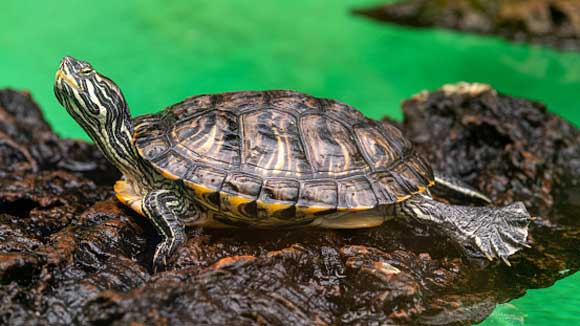
The two pond slider subspecies are also fun to watch as they swim in the tank. If you house more than one Cumberland or red-eared slider in your turtle tank, you’ll be able to see them having lots of fun together.
You’ll watch them swimming around as a group or even basking while stacked upon each other.
Legal protections and conservation status
Neither the red-eared slider nor the Cumberland species is an endangered species and they don’t feature on the IUCN red list. Neither are the two pets of special concern.
However, you’d want to keep in mind that they’re labeled as invasive species and can be a threat to other turtle species if released by their owners into places and habitats they’re not native to.
It’s also worth noting that most states allow you to keep the two sliders as pet turtles.
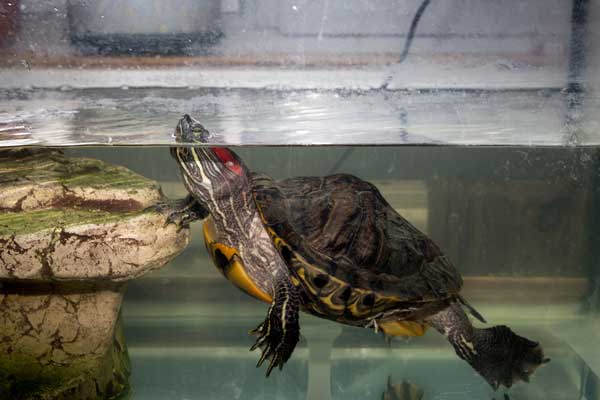
That said, we suggest doing your own research to find out if your local laws allow you to keep a Cumberland or red-eared slider as a pet in your area.
Potential health concerns
Common health problems associated with Cumberland sliders include metabolic bone disease, intestinal parasites, shell infections, and vitamin A deficiency.
The same health issues are common in red-eared sliders.

These problems are usually brought about by poor animal husbandry, so you should take proper care of your turtle if you want it to stay healthy.
We came across this interesting video of a turtle owner comparing the red-eared slider and the Cumberland slider side by side.
Video:
Can Cumberland slider live with red-eared sliders?
Red-eared sliders can be housed with Cumberland sliders since they’re similar in size and share similar habitat requirements.
However, you’ll need to put a few measures in place to ensure the turtles live happily and peacefully in the same enclosure.
Firstly, you’ll need to ensure you put Cumberland sliders that are the same size as the red-eared sliders to prevent the harassing of the smaller turtles.
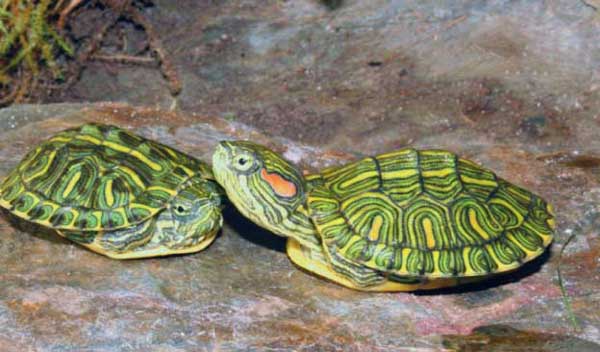
Also, you’ll need to get a more spacious enclosure that will house multiple sliders without making them feel cramped up in a small enclosure.
For every slider you add, you’ll need an additional 20 to 30 gallons of tank space.
You should also upgrade the basking area to make it more spacious, increase the quality of food, and upgrade your filtration system to cater to the additional waste.
If you plan to have multiple sliders in the same enclosure, a large outdoor pond would make a more practical housing for you.
Final Verdict
Cumberland sliders and red-eared sliders are close relatives and belong to the same species of pond slider turtles. The turtles are readily available and highly affordable. They’re also attractive, friendly, and easy to care for, making them a favorite for many turtle enthusiasts across the US and other parts of the world.
As you’ve seen in the above guide, the two slider turtles have the same list of requirements. Their only difference is their looks. They share the same habitat, diet, behavior, and more. Hopefully, the information shared in this guide has helped you make the right decision on which of the two sliders to choose.
